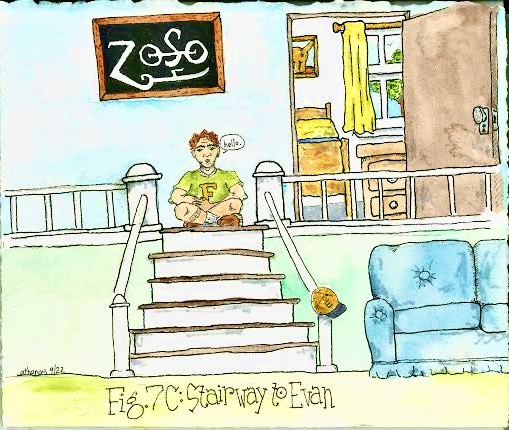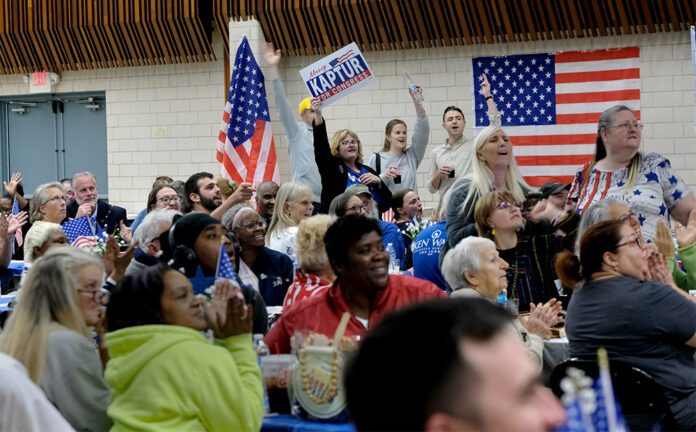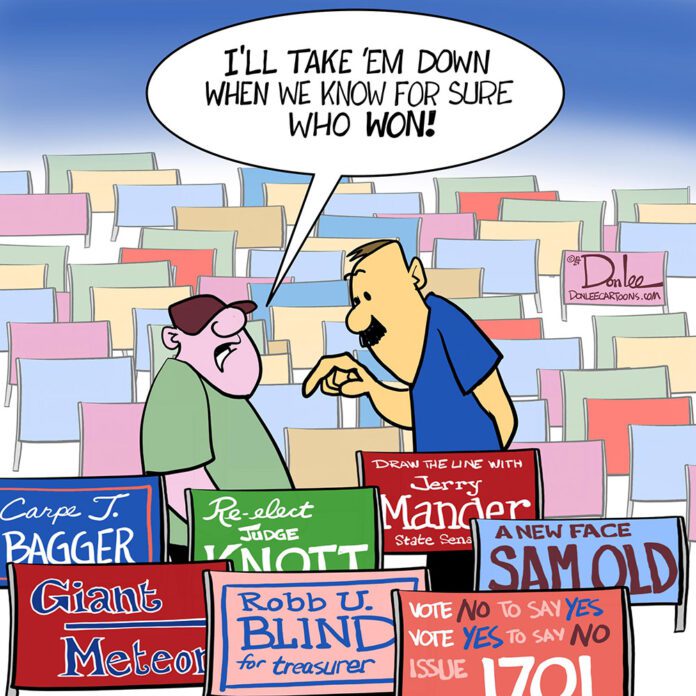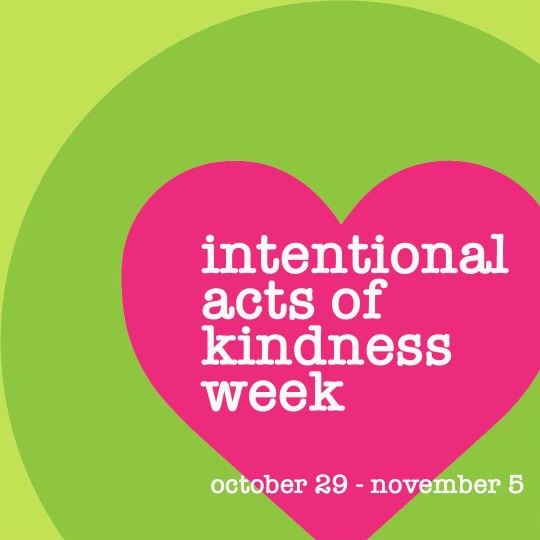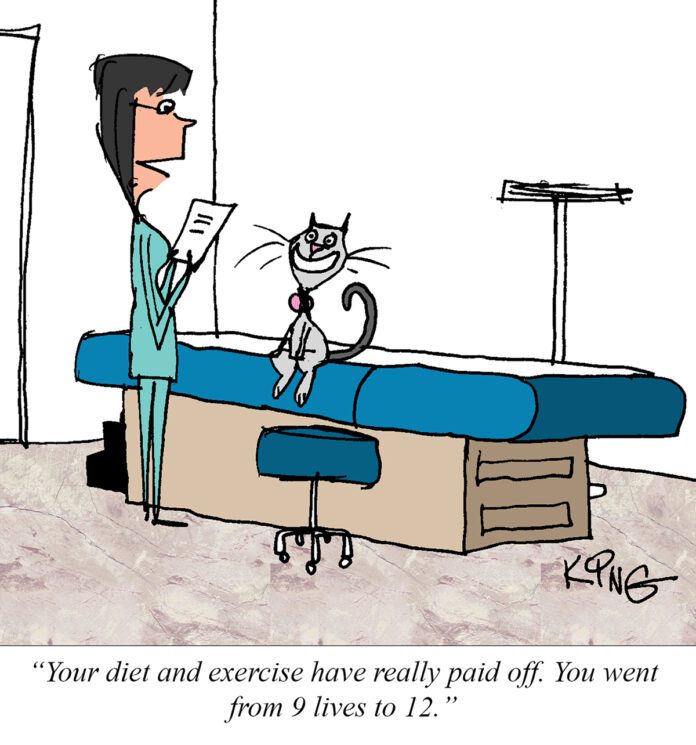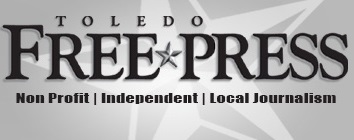Homophone cartoon by Steven J Athanas for the Toledo Free Press.
Libertarian speaks out
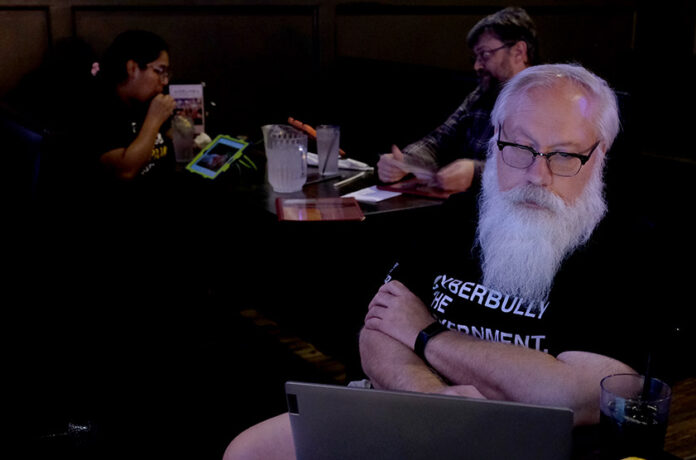

Tom Pruss: ‘I’m happy to offer an alternative to the red and blue paradigm’
Story and photos by Lori King
SYLVANIA – While local democrats and republicans gathered for their respective election watch parties Tuesday night, Tom Pruss was the sole candidate for the libertarian party.
Pruss, running against political powerhouses Marcy Kaptur and Derek Merrin for the U.S. House of Representatives Ohio District 9 seat, was the first to arrive at his watch party at Sidelines Sports Eatery & Pub.
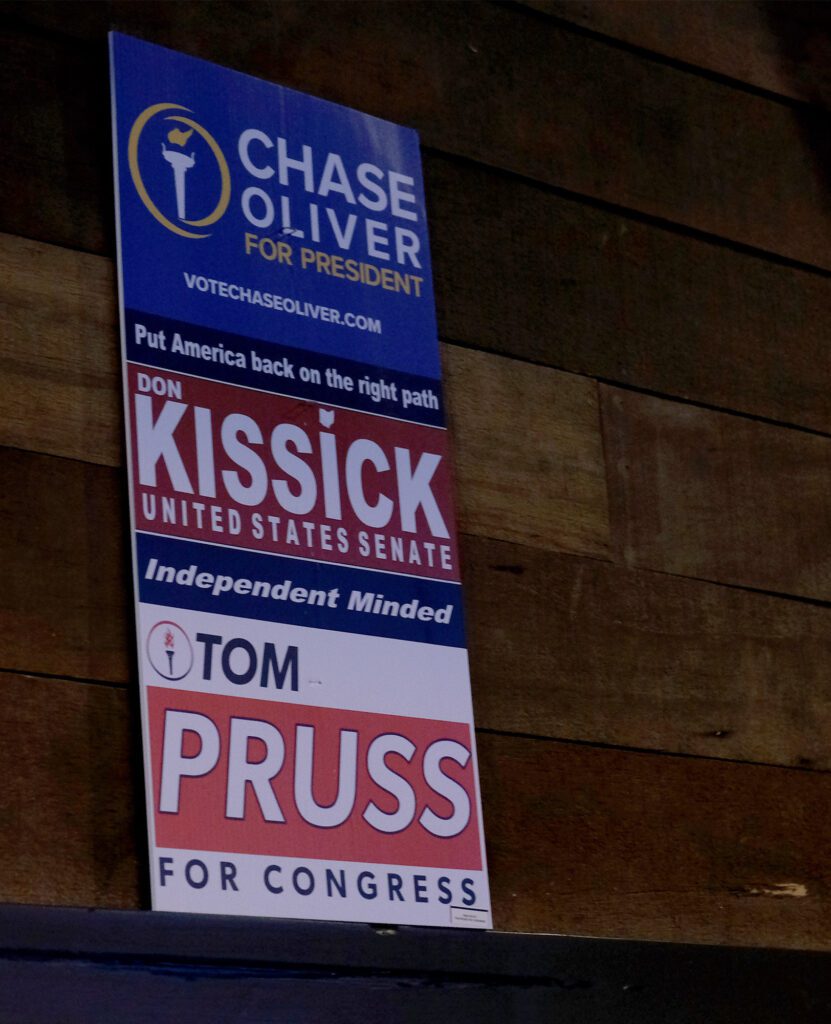
Pruss, a Toledo resident, carried in a political sign that promoted three libertarian candidates: Chase Oliver for president; Don Kissick for United States senate; and himself. He propped the sign up against a wall, sat at a table, opened a laptop and settled into what would be a long night of monitoring election results.
While he waited for his supporters to show up, he took the opportunity to explain why he was in the race and what was at stake.
“This is just the beginning because we just regained ballot access this year,” Pruss said. “Because of the strict Ohio election laws the republicans passed just two years ago, they made it quite hard for third parties to get on the ballot. So Chase Oliver has to get at least 3 percent of the vote in Ohio just to make us relevant to be on the ballot again.
“If we don’t (get 3 percent), that means we spend millions of dollars paying people to go out and get petitions and signatures, and that’s hard money that a third party just can’t afford. I think it’s very daunting, honestly,” he admitted. Oliver ended up with 567, 492 votes, or 0.4 percent.
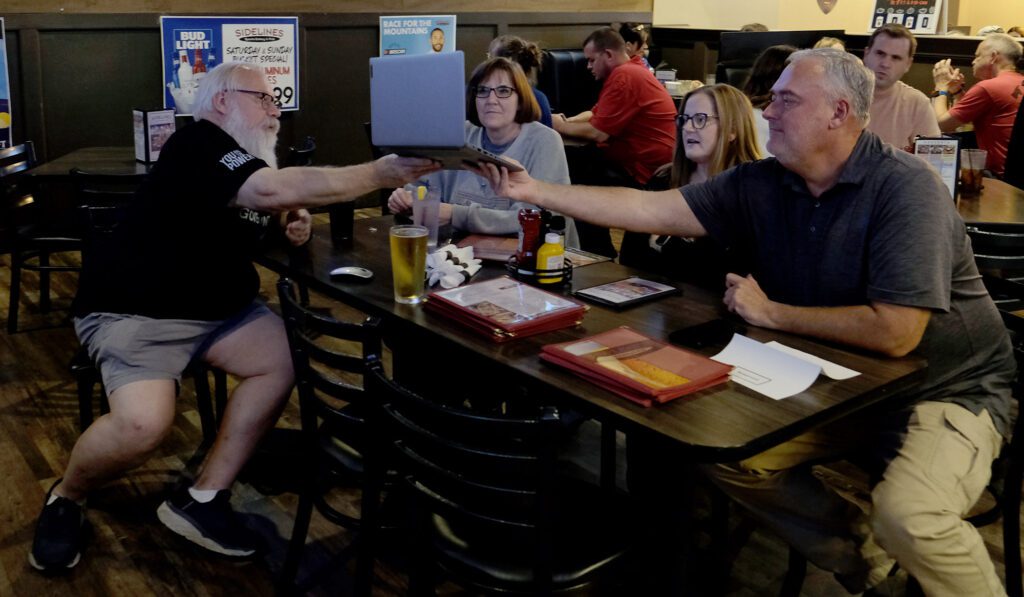

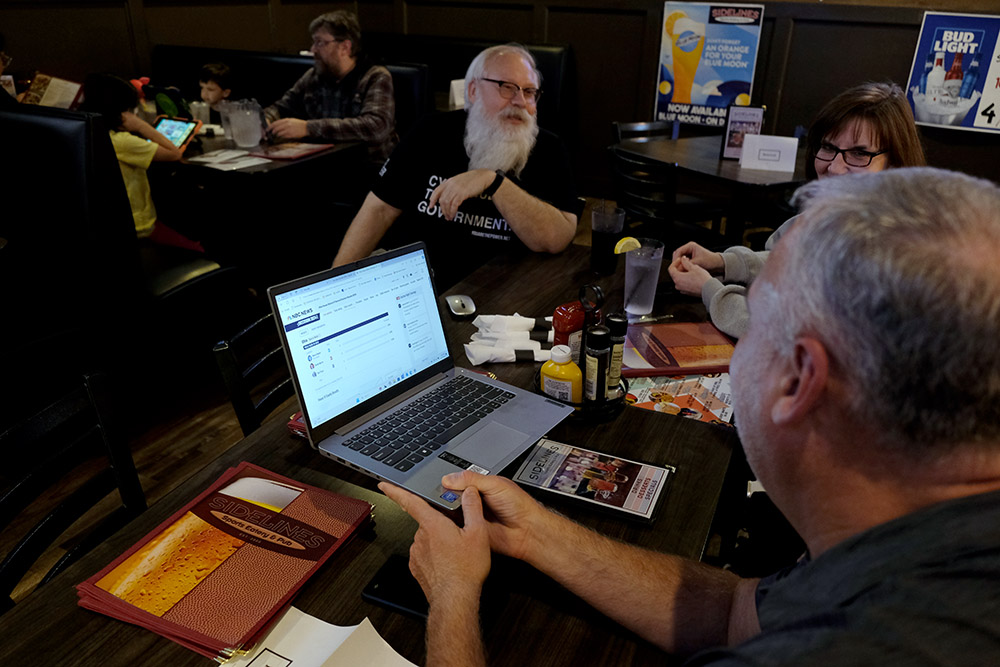

Pruss said their goal is to field more candidates for more seats, and that people seem to think libertarians only come out every four years to run somebody for president. “No, we have people all over the country holding office. In fact, Cassaundra Fryman, the mayor of Plymouth, Ohio, has been mayor for two terms, but you’re not gonna see that on television. We’re all over the place.”
Pruss described libertarians as ordinary people who have a passion for their country, and that “we believe in freedoms that are God-given to us. As I was telling somebody earlier today, the constitution doesn’t tell us the freedoms we have, it’s to tell the government the limits that they to govern over us, and that’s where people make the disconnect,” he explained.
When asked about taking votes away from the other parties, he bluntly stated “horse hockey. People are going to vote for me because they are going to vote for me. Are you going to tell Marcy Kaptur that she’s taking votes away from Derek Merrin and vice versa? That makes no sense to me.
“I have people who with good conscience could not vote for either one. I’m happy to offer an alternative. As my slogan is, I’m not left; I’m not right. I’m sensibly centered,” he said.
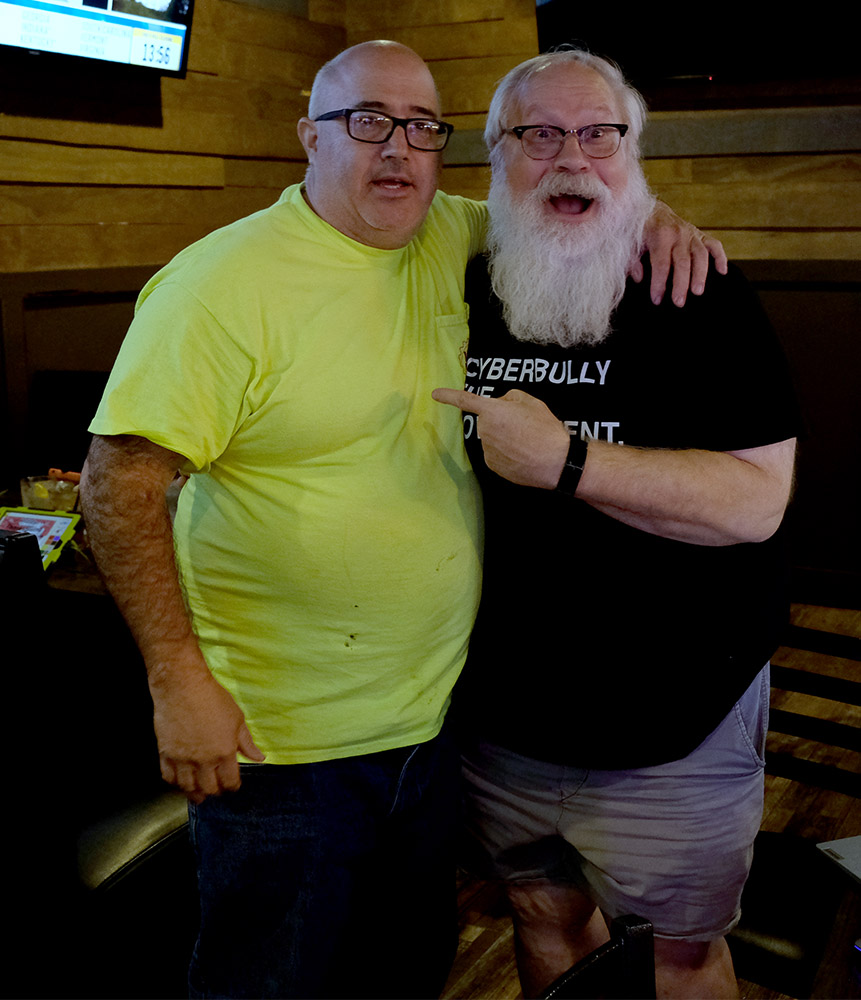

Pruss said his platform is a true smaller government, “not what republicans would consider smaller government. The difference between the republicans and democrats is that democrats are on a bus going 100 miles an hour towards a cliff; republicans say, ‘Oh, hold on here! Let’s go 90 miles an hour.’ Both heading for that same cliff at full rate. Libertarians are like, let’s put on the brake, let’s pause and take a look to see what we’re doing with our money.”
He added that “every year that Marcy Kaptur is in office, she’s voting for arms to blow up innocent children all over the world in my name. I don’t like that. Conversley, I don’t like Derek Merrin being in Columbus passing legislation that doesn’t grant everybody bodily autonomy. The insanity has to stop.”
Pruss said he was happy to offer an alternative to the red and blue paradigm that everybody thinks they’re forced to have to vote for, and that you shouldn’t be forced to vote for the lesser of two evils because the lesser of two evils is still evil. “I just want to go out there and earn people’s vote, as an independent, as a libertarian. Ideally, I want to be a spoiler.
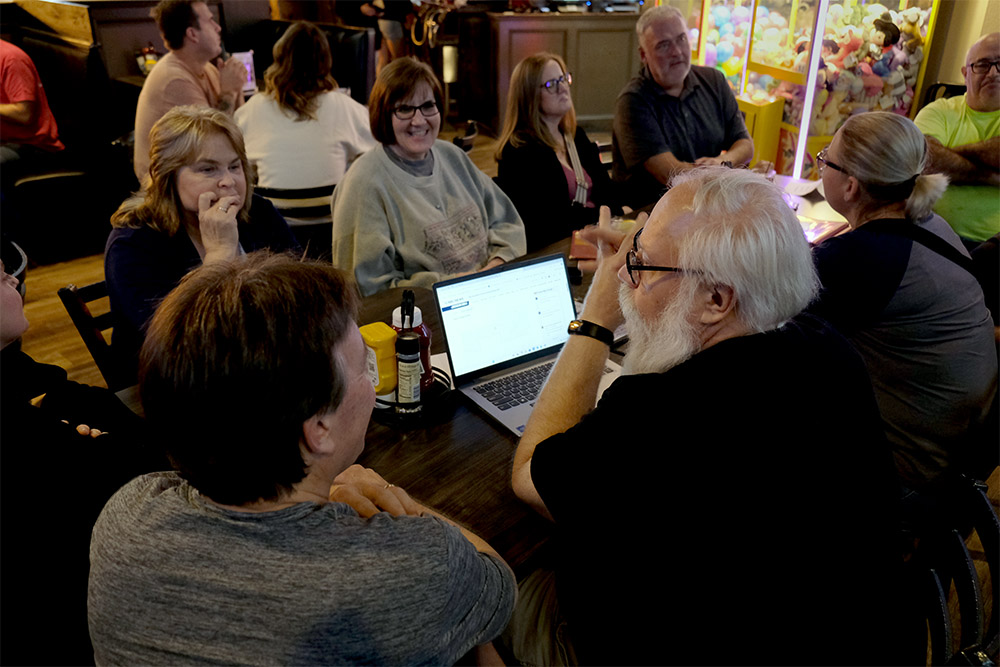

“I’ll think I’ll run away with 15 votes,” he quipped.
“Hey, it’s a start,” responded Scott Macy, a libertarian who voted for Pruss and then came straight to the watch party.
He told Pruss, who was complaining about the media ignoring him, that “I think you started something (on Facebook) because you talked about how nobody wanted to know you.” Macy insinuated they clearly did.
After about an hour, Pruss was surrounded by a dozen supporters who said they all voted for him. Pruss ended up earning 4 percent of the vote.
For complete election results, go to WTOL Election 2024.
(See full photo gallery on bottom of the homepage)
Related content
Local election favors dems
Lucas County stays blue as Ohio turns dark red
Story and photos by Lori King
TOLEDO – As Ohio, and much of the country, awoke this morning to a red wave, it was a different story for the blue dot that is Lucas County.
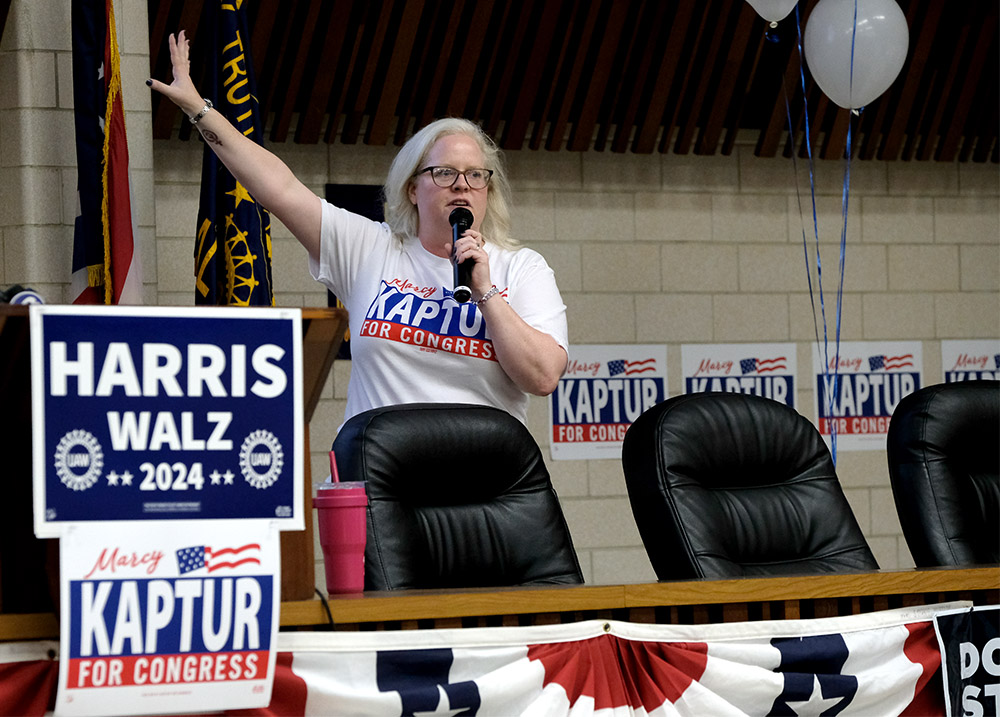

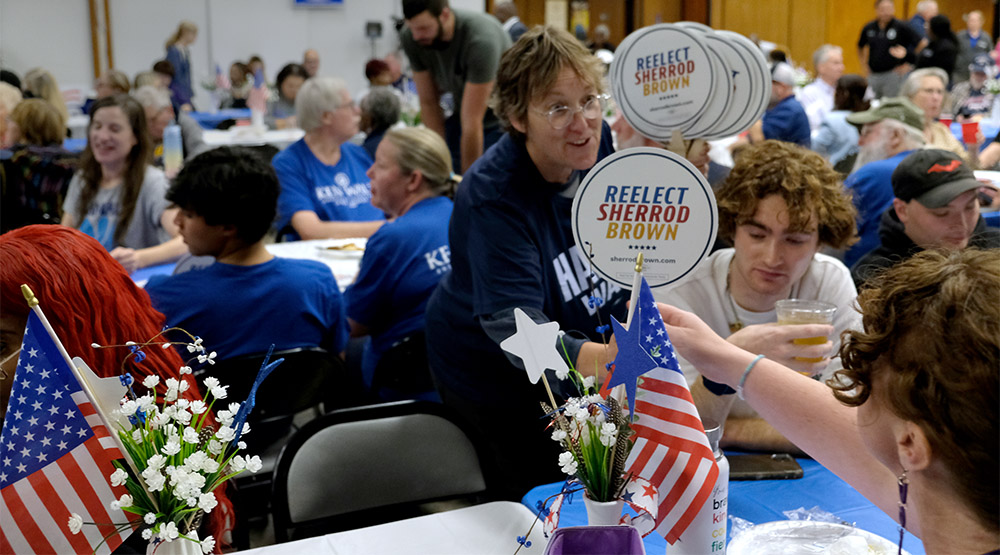

The mood at the democratic watch party inside the UAW Local 12 Union Hall on Tuesday night was mostly cheerful as hundreds of supporters and elected officials celebrated each time a local democrat claimed victory, or a local issue passed, like Issue 9, the Toledo mayoral term limit expansion.
But, at times, there were bouts of somber silence as they watched Issue 1 fail and realized businessman Bernie Moreno was going to defeat populist Sherrod Brown.
Earlier in the evening, when the numbers were favoring Brown, democratic volunteer Krista Schneider enthusiastically passed out dozens of handheld signs that read ‘Reelect Sherrod Brown.’
“Love, life and moving away from hatred,” she proclaimed as she handed out the placards in support of the union-friendly Brown, who was at a different watch party at the Hyatt Regency Downtown Columbus Convention Center Hotel in Columbus.
Standing nearby was Michele Grim, and as she took a Brown handsign, she said “he’s with us in spirit and in our hearts and minds.” Grim, who was running for an reelection bid to serve in the 43rd House District, securing that seat.
Also present inside the union hall were winners of their local elections: Toledo city council at-large newcomer Mac Driscoll, winning by a resounding 70 percent; Lucas County commissioner Pete Gerken; Lucas County Common Pleas judge Ken Walz; Lucas County State Rep. Grim; and Erika White, who will take the seat for the state’s 41st District.
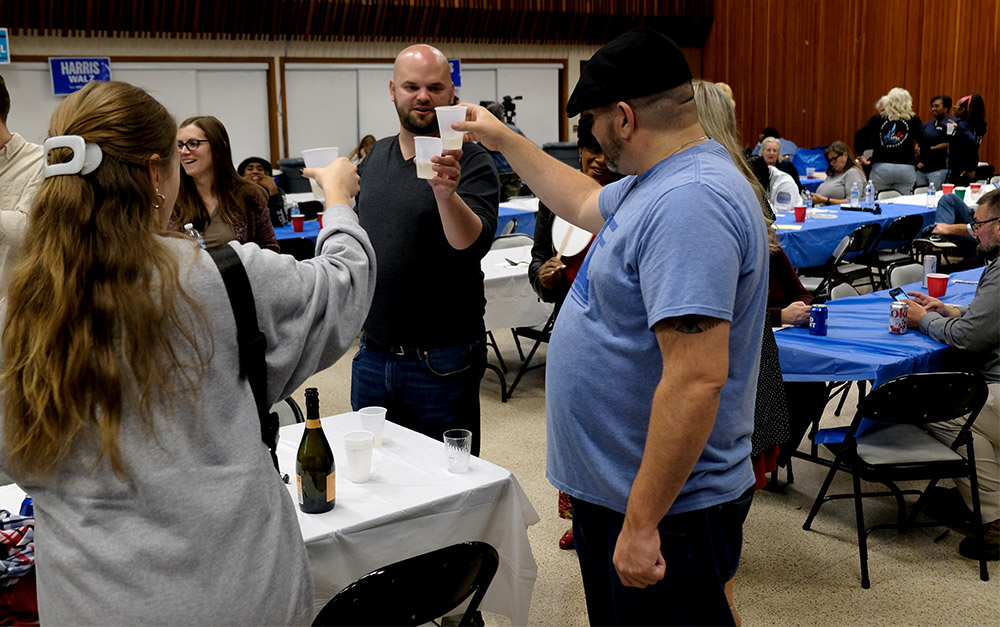

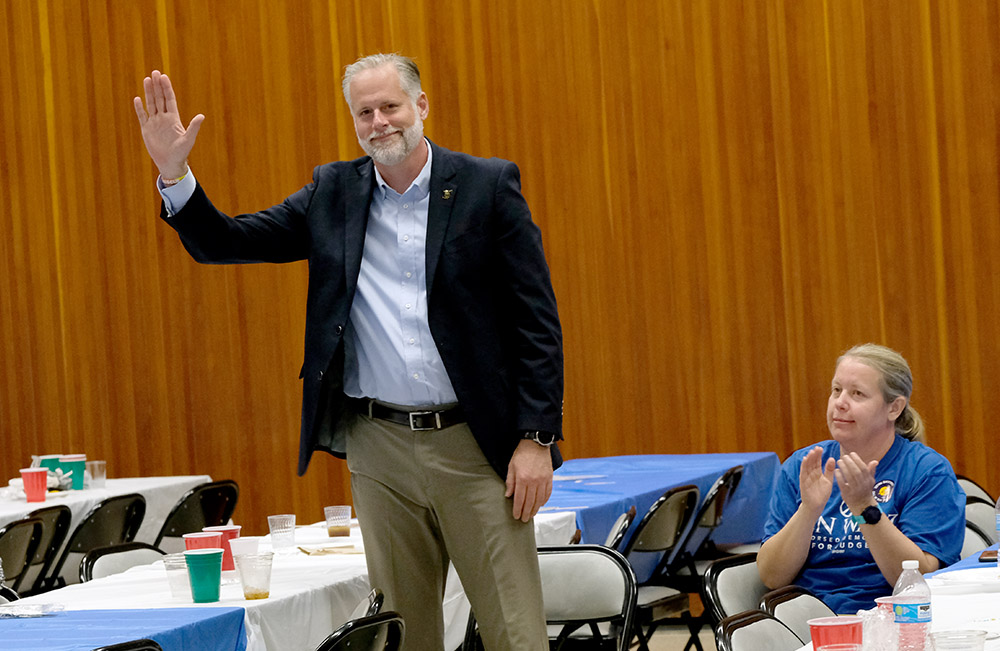

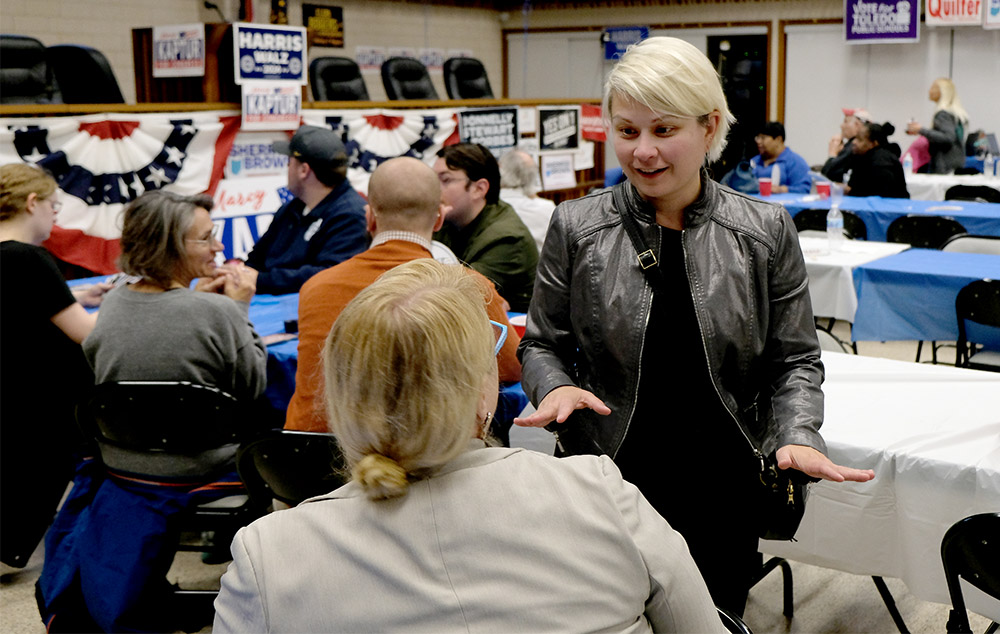

One of the more celebratory moments was when Driscoll toasted to his victory with Ruffino Lumina Prosecco in clear plastic cups.
Expected to arrive later in the evening was Congresswoman Marcy Kaptur, 78. Kaptur is serving her 21st term and battling the race of her political career against Derek Merrin. Merrin’s political career began in 2005 when he was elected to the Waterville city council. He was just 19, becoming the Waterville mayor two years later.
But, at 11:30 p.m., UAW Local 14 President Tony Totty walked up to the podium and announced to the dwindling audience that she wasn’t going to make an appearance.
As of the publishing of this story, the race between Kaptur and Merrin for U.S. House of Representative Ohio District 9 is still too close to call. Both are tied at 48 percent, though Kaptur has a 1,193 vote lead.
For complete election results, go to WTOL Election 2024.
(See full photo gallery on bottom of the homepage)
Related content
Coach Boggess era begins
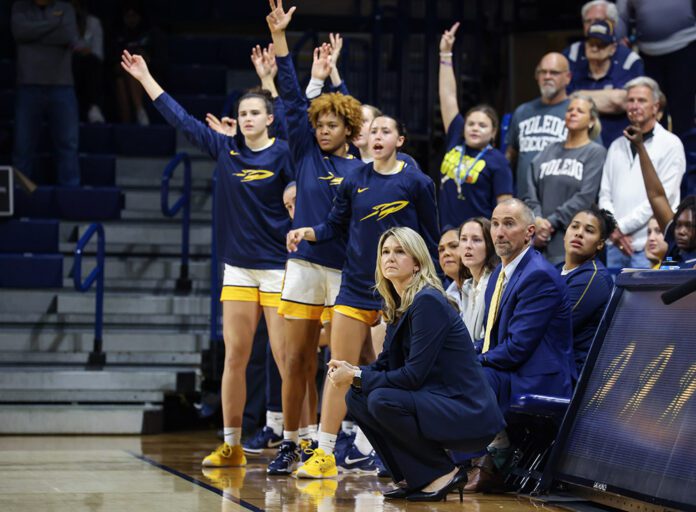

New season lifts off for Toledo women’s basketball
Story by Steve Bieber | Photos by Scott Grau
TOLEDO – Head coach Ginny Boggess has a perfect 1-0 record after winning her first game against Marshall on Monday.
It was a fitting debut as Toledo women’s basketball kicked off its 50th anniversary season in front of 3,754 fans who welcomed the new coach to Savage Arena with great enthusiasm.
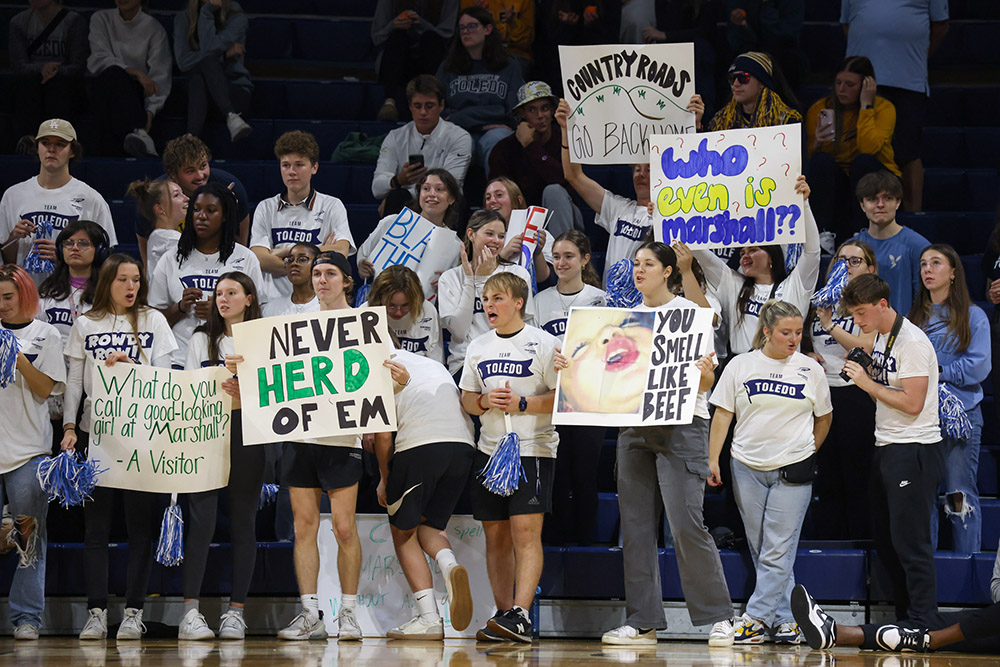

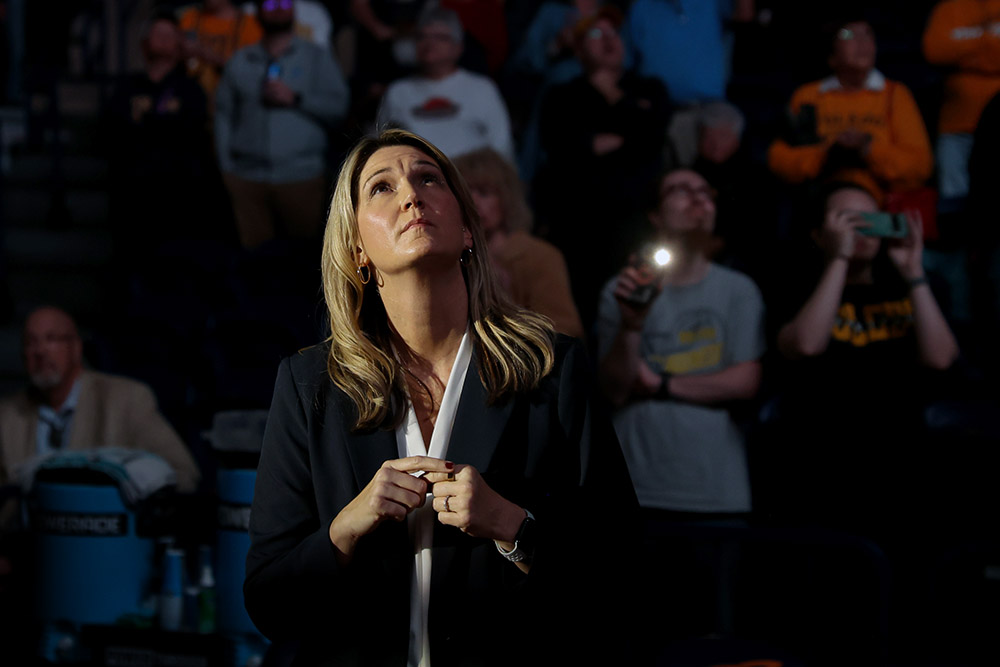

Boggess spent the past three seasons as head coach at Monmouth University in New Jersey, where she inherited a two-win team and coached them to a NCAA tournament appearance.
The Rockets starting slowly, allowing Marshall to surge to 22-8 in the first quarter, but they turned it around and outscored the Herd each quarter after that, eventually chipping away at the lead. It wasn’t until early in the fourth quarter that Toledo took the lead after center Hannah Noveroske‘s layup put them up 56-54.
Both teams battled back and forth in the fourth quarter until Kendall Carruthers, a Springfield High School graduate, made a jump shot with 25 seconds left to give the Rockets the go-ahead three-point lead. Marshall had the chance to tie the game with five seconds remaining but failed after Maddie Kellione’s three-point basket was called off due to a traveling violation.
Despite the rough start, Boggess spoke highly of her players for pulling it off.
“First and foremost, I want to thank the sixth man here at Savage Arena for showing up and showing out tonight,” she said. “I was really excited how our seniors led, and we’ve got some talented young players who stepped up in big moments for us.
“Overall, the toughness, the resiliency, the championship culture and the ‘Blue Collar, Gold Standard mentality’ was really shown tonight and I’m proud of our fight,” she added.
The coach said she had been awake since 4:48 a.m., feeling eager all day leading up to the game, and feeling excited for her seniors and the rest of the team. She also discussed the impact of the fans and said the home crowd lived up to her expectations.
“It’s amazing. I walked down and just got goosebumps all over my body; this is a really really special place.”
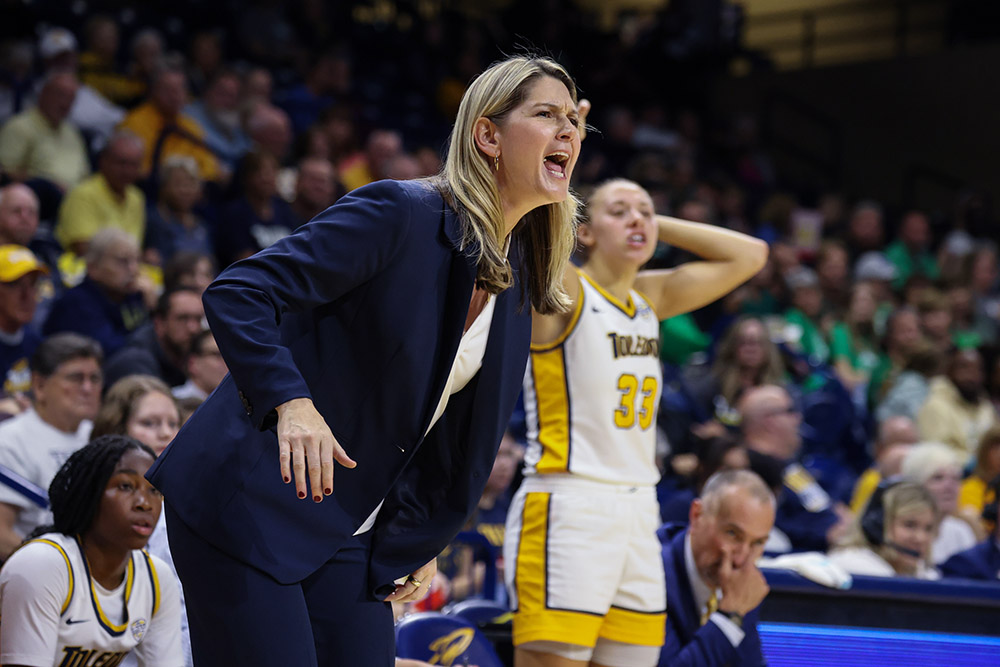

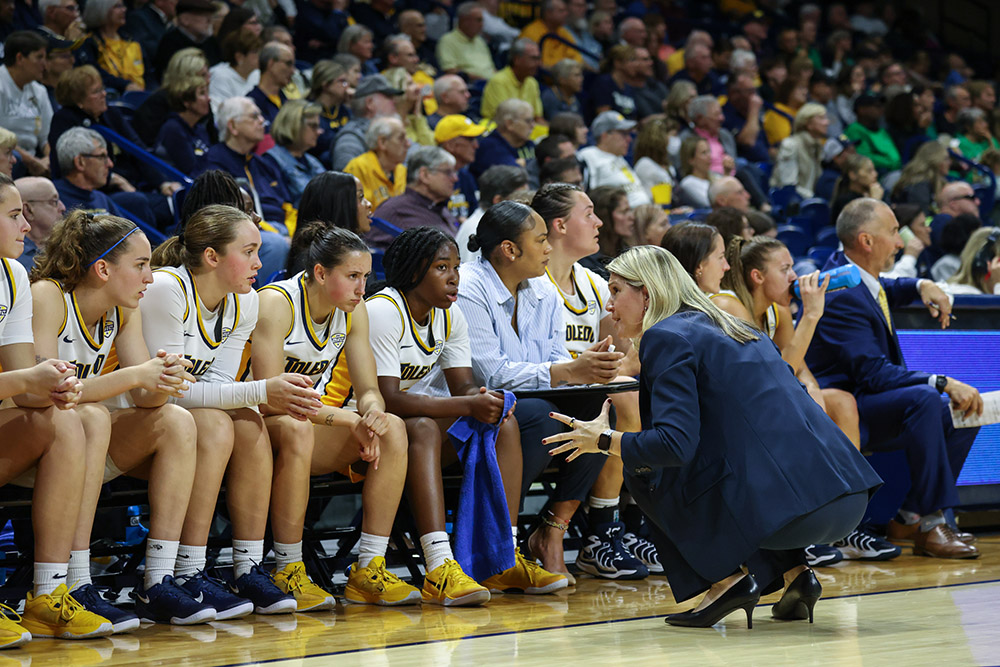

Boggess has made it her mission to continue the tradition at the university.
“I’m here because of the leadership and tradition and because women’s basketball is important at the University of Toledo. We want to keep that tradition going. I really believe this is a special place and these are special players. We’ll continue to keep working really hard to represent you guys,” she vowed.
One fan watching the season opener was Toledo native Dick Greenblatt. He has been a fan since he graduated from the university in 1967. He said he was impressed with what he saw from the new head coach.
“I like her. I think she’s got a lot of good ideas and she’s going to work out just great,” he said.
Sylvania resident Kaiko Zureich has been following the Toledo’s women’s basketball team for 15 years. She is not only a fan but a mentor to freshman Jessica Cook. She felt that the future is bright for the players and new coach.
“We have a great new coach. The girls are really coming together as a team. I am a mentor so I talk to the girls a lot, and I’m excited about this season. They’ll get it together and we’re going to go far,” Zureich said.
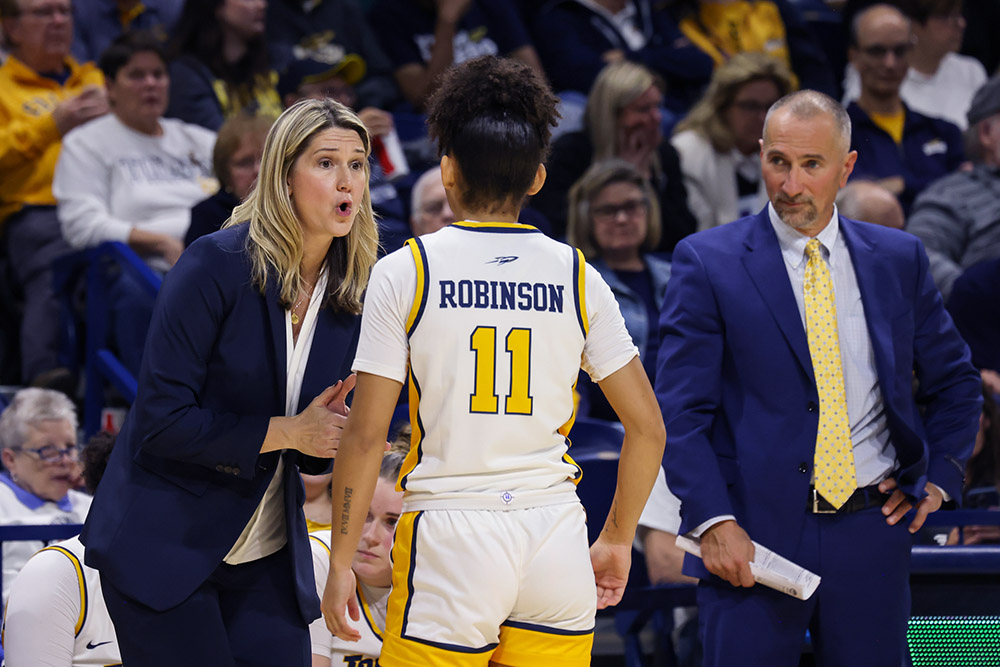

Game Recap
First Quarter
- Marshall scored 10 points to start the game, but Toledo finally scored when Noveroske made a layup with 5:55 left in the first quarter.
- Toledo trailed 16-5 at the first media timeout, and the Rockets made 18 percent of their field goals.
- A jump shot from Sammi Mikonowicz and a free throw from Emmi Rinat cut the lead to 22-8 at the end of the first quarter.
Second Quarter
- Mikonowicz’s three-point-play and a layup from Faith Fredd-Robinson helped cut the lead to 28-19 at the 4:45 mark.
- The Rockets battled back and outscored Marshal 21-15 in the second quarter.
- Toledo’s offense showed improvement after shooting 8-16 and received help with a huge trey from Nan Garcia near the end of the half to cut the lead to 37-29.
Third Quarter
- Mikonowicz opened the half with a layup to make the lead 37-31.
- Rockets trailed 44-41 at the break after shooting 5-of-8 from the floor.
- Toledo cut the lead to one when Cook made a layup to make the score 44-43 with 3:46 left to play.
- After trading baskets, Khera Goss nailed both free throws to help Toledo pull within one again as Toledo trailed 54-53 after three quarters.
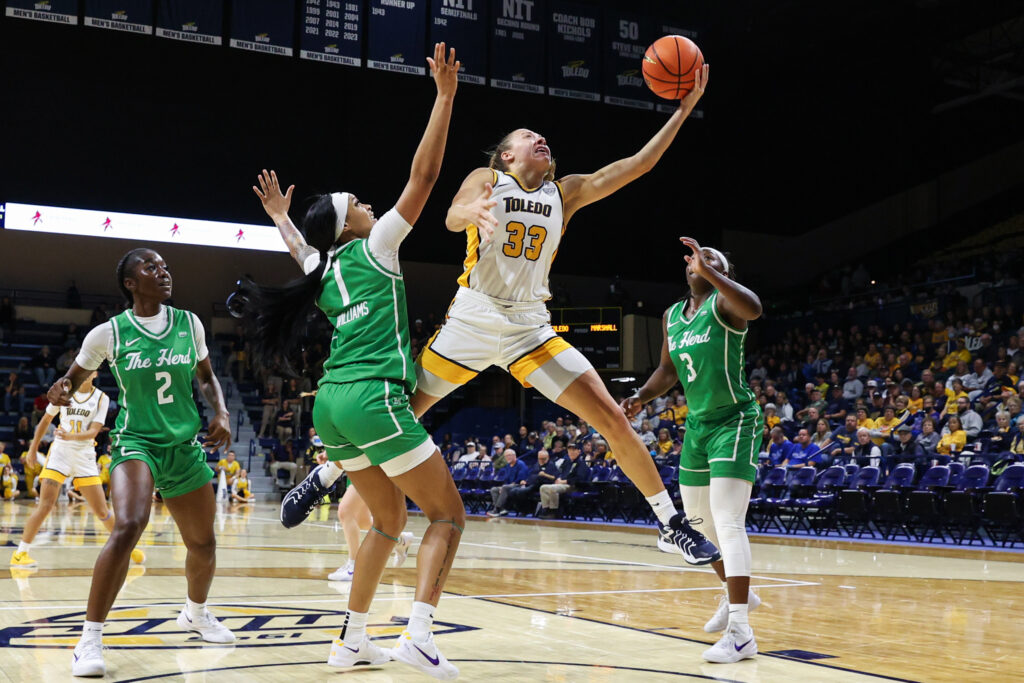

Fourth Quarter
- A layup from Noveroske gave the Rockets their first lead at the 9:28 mark of the fourth quarter.
- After battling back and forth, the Rockets led the Thundering Herd 64-61 after Garcia made both free throws with five minutes left to play.
- Kendall Carruthers’s jump shot gave Toledo a 71-68 lead with 25 seconds left in the game.
- Marshall’s Kellione had a chance to tie the game with .07 seconds left, but traveled, giving the Rockets the win.
Noveroske and Mikonowicz led the team in scoring with 16 and 15 points, respectively.
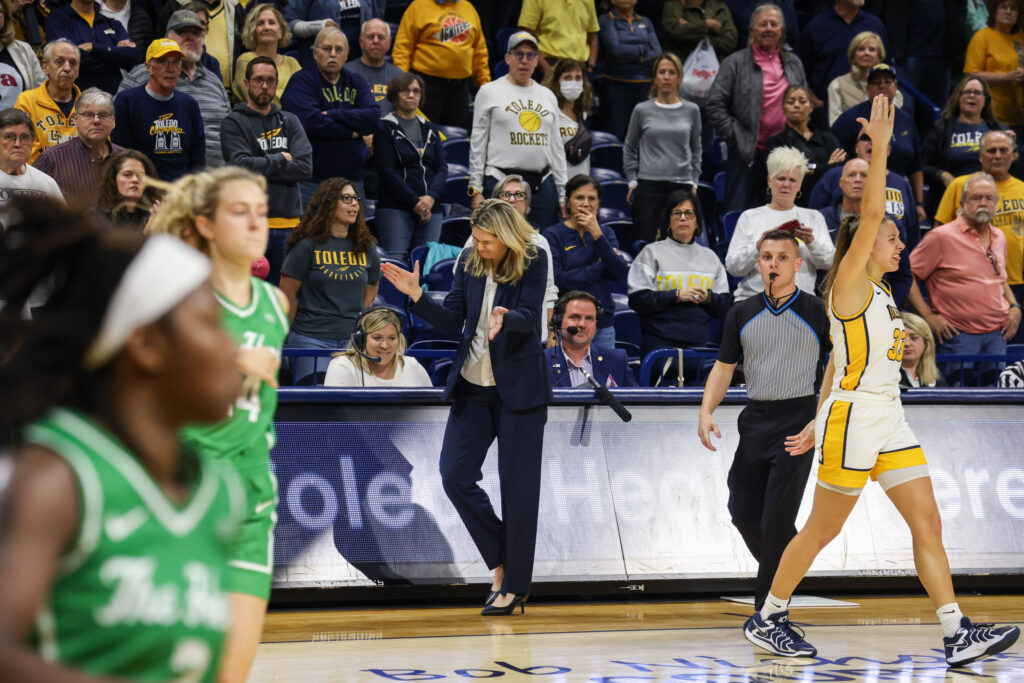

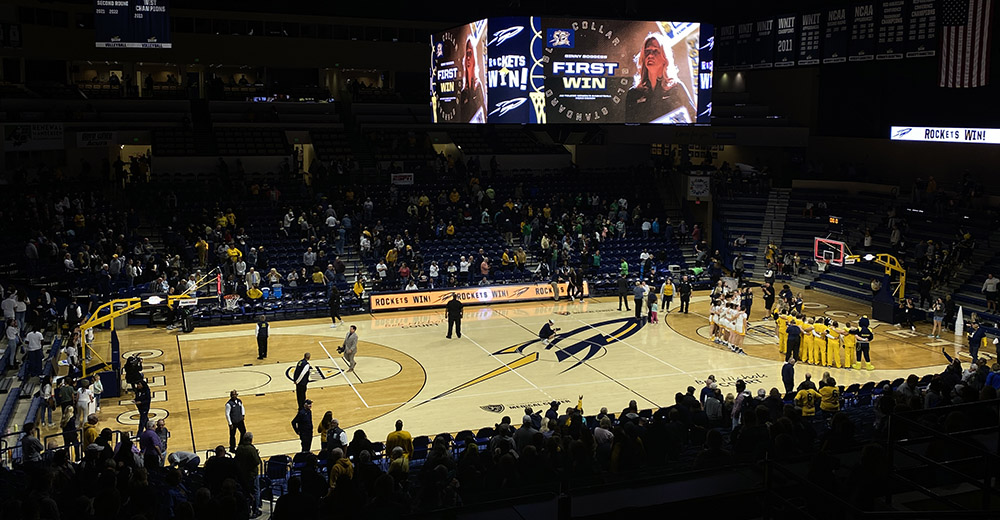

Local republican results mixed
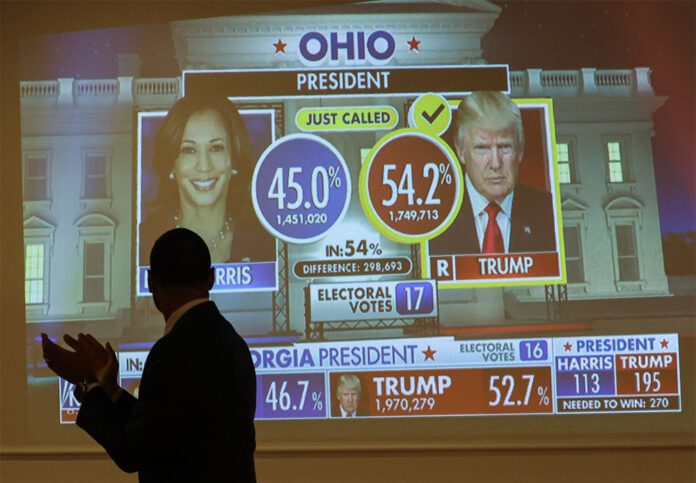

Bernie Moreno is big local winner of election night
Story and photos by Scott W. Grau
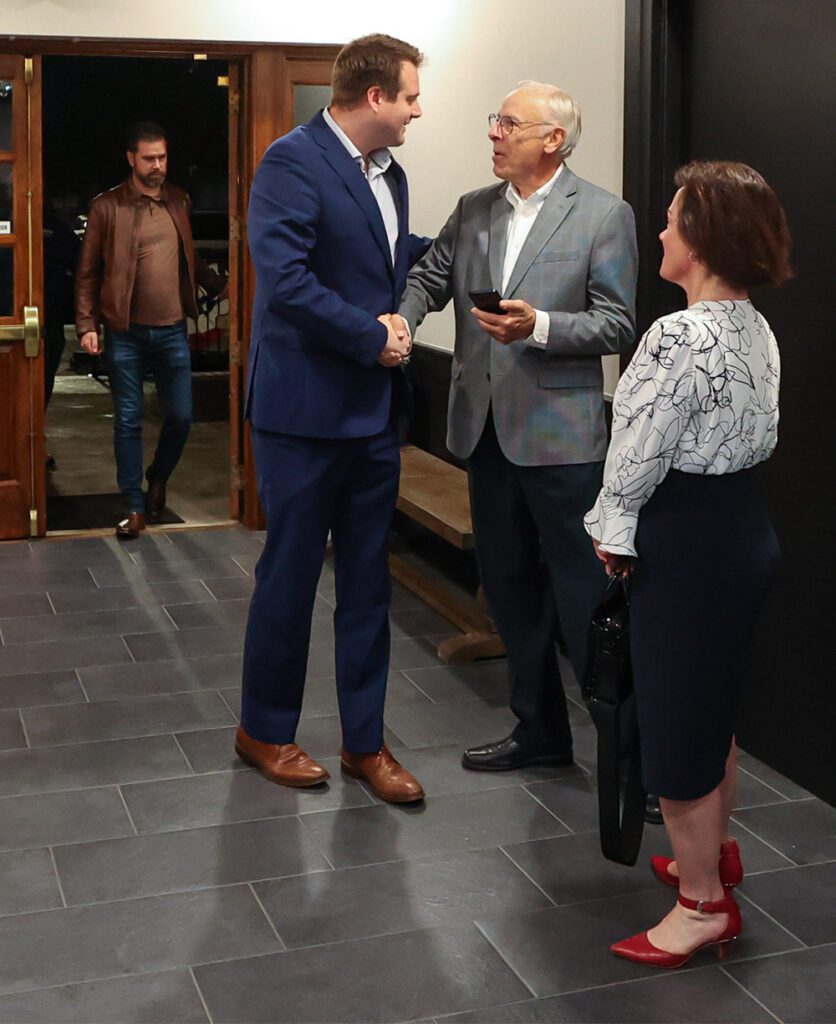

HOLLAND – Supporters, volunteers, elected officials and candidates gathered at the Lucas County Republican Party election night watch party at the Holland Gardens Banquet Hall on Tuesday night to watch the results of the local, state and national elections.
Derek Merrin, running for U.S. House of Representatives against incumbent Marcy Kaptur, made a late-night appearance but chose not to make a speech to his supporters. Although he was behind in the vote count against Kaptur, the margin of difference was less than 0.05 percent, which automatically triggers a vote recount.
The makeshift stage Merrin would have made either a victory or concession speech from remained empty for the night.
Incumbent Ohio house representative Josh Williams celebrated his victory over challenger Dave Blyth. Throughout the evening, Williams was seen checking his smartphone as the results were being reported. Once it was announced he was the projected winner, his supporters erupted in cheers.
With the news that he retained his seat, his wife, Neaira Williams, promptly planted a kiss on his cheek.
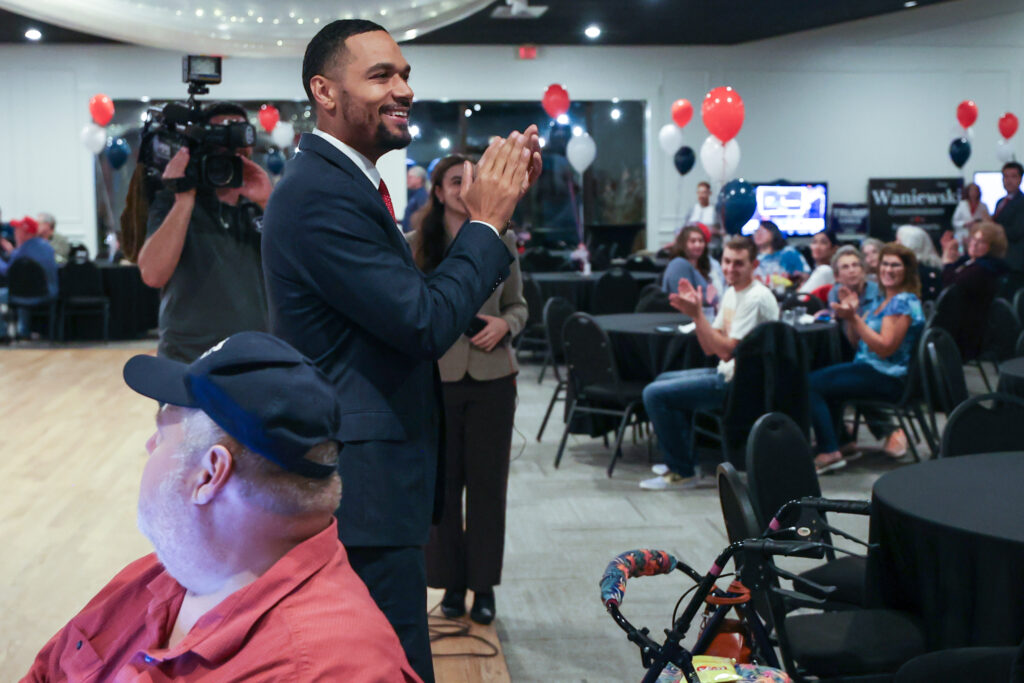

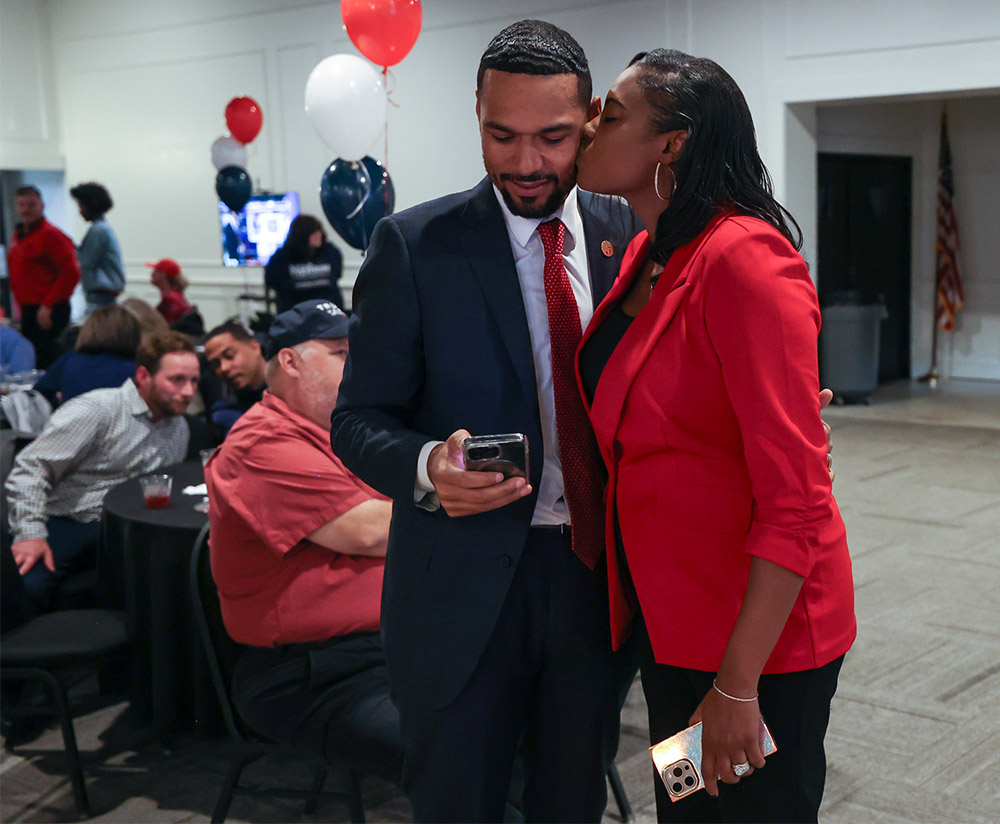

Candidates for Lucas County commissioner John Rozic and Tom Waniewski were in attendance as they anxiously waited for the results of their races to be reported. Rozic was defeated by incumbent Anita Lopez and Waniewski fell to long-time incumbent Pete Gerken.
A highlight of the evening was when the announcement was made that candidate Bernie Moreno narrowly defeated Sherrod Brown for the U.S. Senate seat.
The atmosphere was upbeat and celebratory as elections results for the presidential race were reported. With each report of projected states won by presidential candidate Donald Trump, cheers and hand clapping rang out throughout the venue. As the number of electoral votes inched closer to the require 270 threshold, the excitement increased.
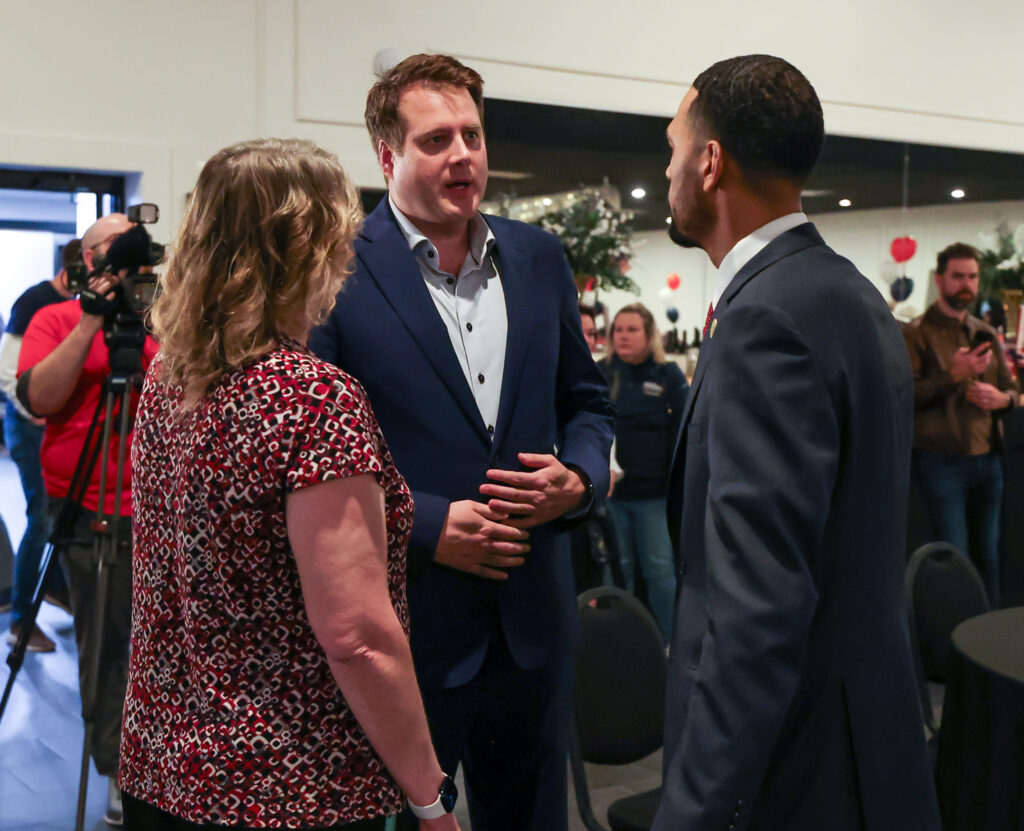

For complete election results, go to WTOL Election 2024.
Related Content
First Latino credit union
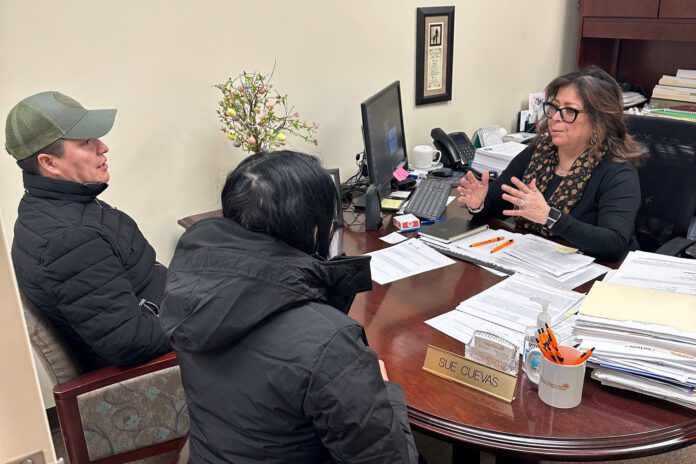

Nueva Esperanza Community Credit Union empowers Latino community
TOLEDO – Located in the heart of Toledo’s south side on Broadway St., Nueva Esperanza Community Credit Union (NECCU) is making cultural history while financially empowering local residents.
As Ohio’s first and only Latino credit union, NECCU has been serving its members since 2010. Under the guidance of president and CEO Sue Cuevas, it has not only grown, it continues to thrive, reflecting the resilience and determination of the community it represents.
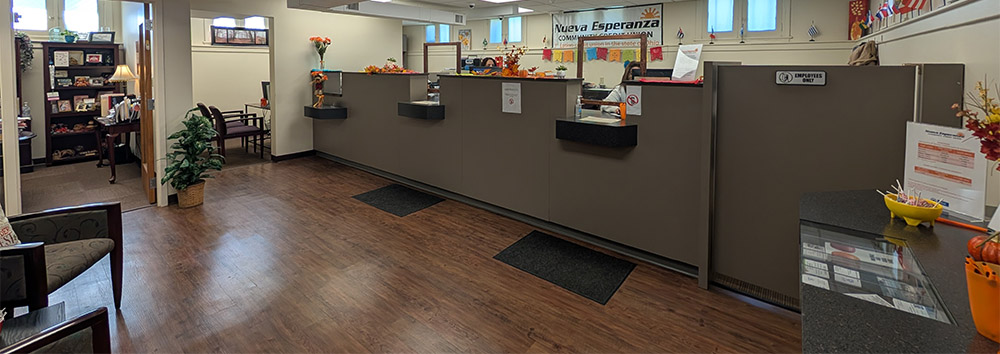

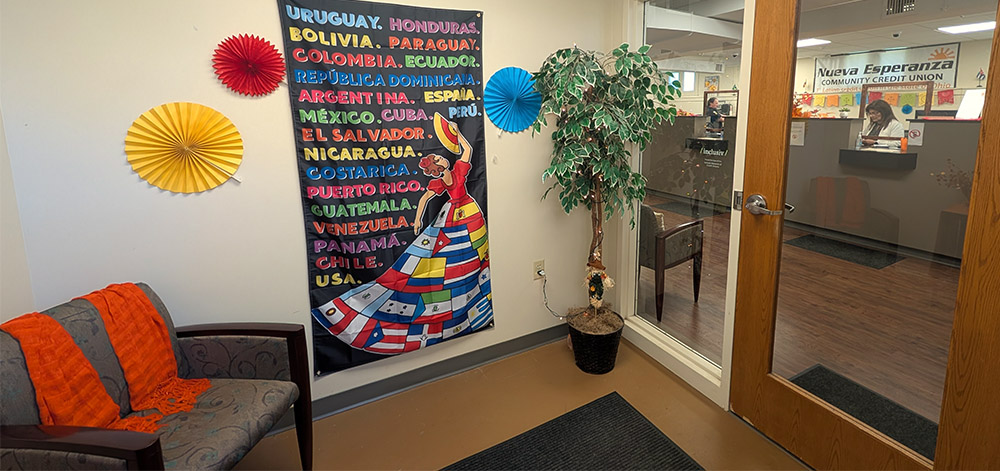

Identifying the need
The creation of the federally insured, state-chartered credit union was spurred by a deep-seated need within the Toledo community to address major gaps in financial services, particularly for the Latino population.
“There was a group of Hispanic leaders and business owners who noticed the prevalence of check cashing places and predatory lending targeting the Hispanic community,” Cuevas said. “There was no place where they could go to a financial institution and have someone help them, guide them or instruct them,” she said.
That’s when Cuevas took action. “I wanted to guide them, show them and teach them that it’s not okay to pay unreasonable interest rates just because they don’t have credit,” she explained.
Financial empowerment for the Latino community
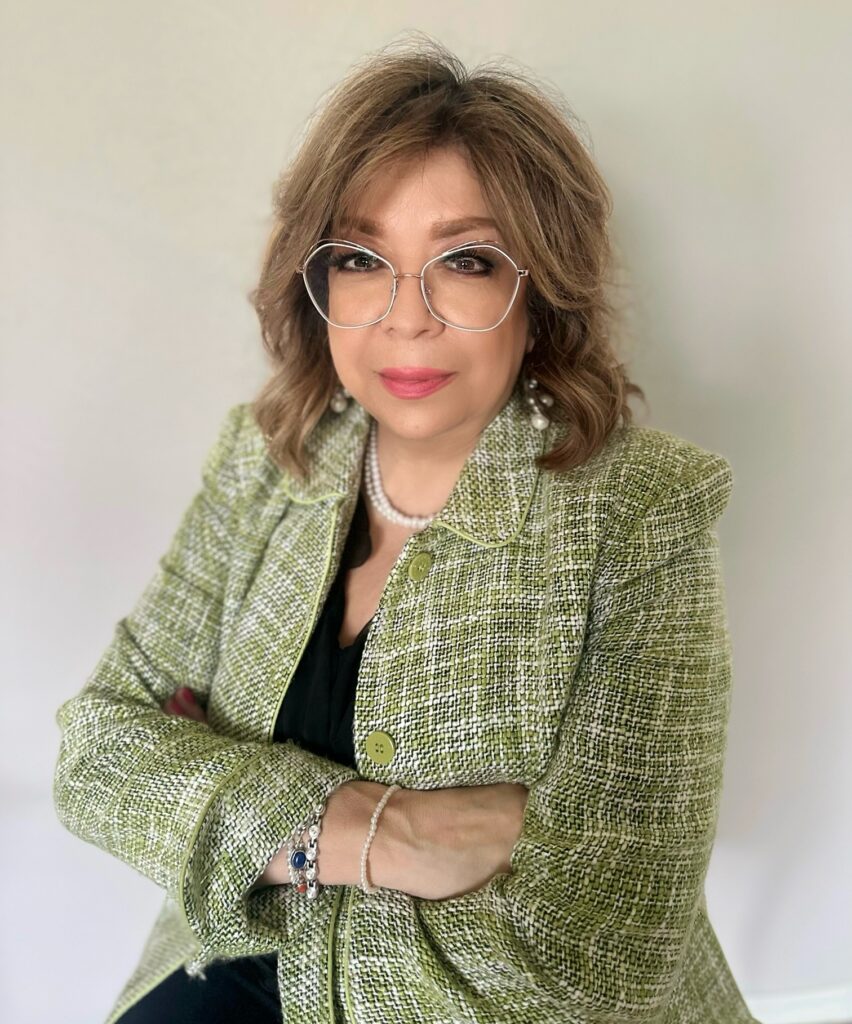

For the past 14 years, Cuevas has grown NECCU, which now boasts over 625 members across its Toledo and Columbus locations, with assets approaching $3 million, all while pursuing a mission to promote savings, enhance financial literacy, provide loan capital, and link members with vital community resources.
“Our goal is not just to offer financial products, but to educate and uplift our members,” she added. “We want to instill confidence in our members that they can build their own credit.”
Serving a primarily Latino membership—though everyone is welcome — the credit union offers a comprehensive range of financial services, as well as traditional checking accounts, including savings accounts, loans and reloadable Visa cards.
In fact, the Ending with the Heart program starts members with a $500 credit-building loan to help establish credit after making consecutive on-time payments for 12 months, enabling them to make larger purchases while feeling confident and comfortable.
Cuevas says members have great success with this program. “I’ve seen them start with $500 and come in and ask for an $8,000 to $10,000 personal loan, and they’re going to get it.”
“Yvette Villanueva and her husband, Jose Carlos Padilla have been members for 10 years. Villanueva said, “We have had several loans through NECCU that have not only helped us personally, but also contributed to the success of our small business.”
Villanueva and Padilla take advantage of several offerings from NECCU, including a savings account, personal loans and auto loans for their businesses.
“I do not believe we would have had the growth we’ve had these last five years without the support of Sue and NECCU. What we like most about being a member is the friendly staff and having people that truly understand the struggles that minorities and small businesses face,” she added.
The Challenges and the Future
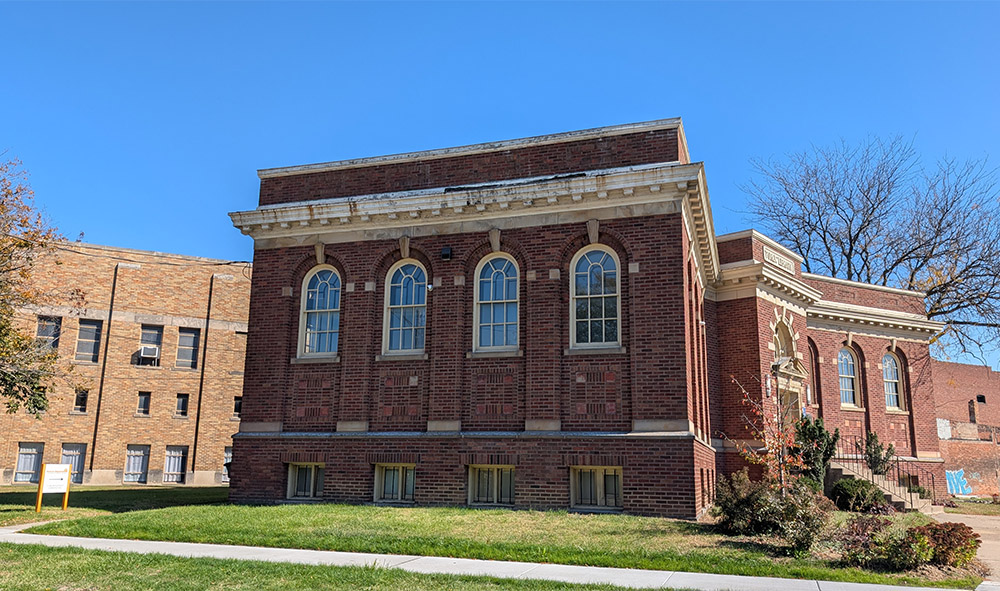

Cuevas acknowledges that the journey hasn’t been without its challenges; it took nearly seven years before the National Credit Union Administration and the Ohio Department of Financial Institutions authorized NECCU as a start-up.
With a small yet dedicated team of two part-time employees in Toledo and a part-time assistant in Columbus, the credit union staff plays a crucial role in day-to-day operations, and in building trust within the community. Cuevas has managed to juggle multiple roles herself, including being a bank secrecy act officer, a teller and a loan officer, ensuring all quarterly and annual reports are completed.
Looking into the future, Cuevas hopes for expansion in some capacity while making certain that current members and new ones receive the same dedicated service. “Credit unions are about people helping people; it’s our duty to inform and make people aware.”
“Everybody has a way of helping people in the community, and there’s not a right way or wrong way. It’s just how we serve in our communities that makes a lasting impact,” she said.
For more information, visit the Toledo branch at 1638 Broadway St., lower level, or their website at Nueva Esperanza Community Credit Union.
Kindness unites neighbors
Neighbor to Neighbor continues kindness, peace initiative amid political conflict
LUCAS COUNTY – Throughout the political season you may have seen the bright green Love your Neighbor signs in front yards around Lucas County. These signs by Neighbor to Neighbor represent kindness and neighborly love, despite conflicting political views.
Neighbor to Neighbor is a non-partisan and nondenominational 2024 election year peace initiative by St. Michael’s in the Hills Episcopal Church. The organizational initiative is promoting Intentional Acts of Kindness Week leading up to the general election, which ends tomorrow.
Neighbor To Neighbor’s next event, “We Are Still Neighbors,” will be at the Enrichment Center of the Glass city Metropark on Sunday, Nov. 17, following the conclusion of the 2024 general election. To sign up, go to We Are Still Neighbors.
Carol Nichols, a member of St. Michael’s and a leader of Neighbor to Neighbor, said regardless of the election turnout, we are still neighbors, and the simple supper event is aimed to bring the community together as a collective.
Alongside the meal, the community will be discussing the future of the Neighbor to Neighbor program in Toledo and brainstorming solutions to community tensions.
“People really are hungry for this kind of thing,” said Nichols. “It has been a bright light for many of us during this very stressful political season.”
Neighbor to Neighbor campaigned Intentional Acts of Kindness Week from Oct. 29 until Nov. 5, but it was ultimately up to the greater Toledo area to commit acts of kindness and share them with the organization on their Facebook or Instagram pages to be featured.
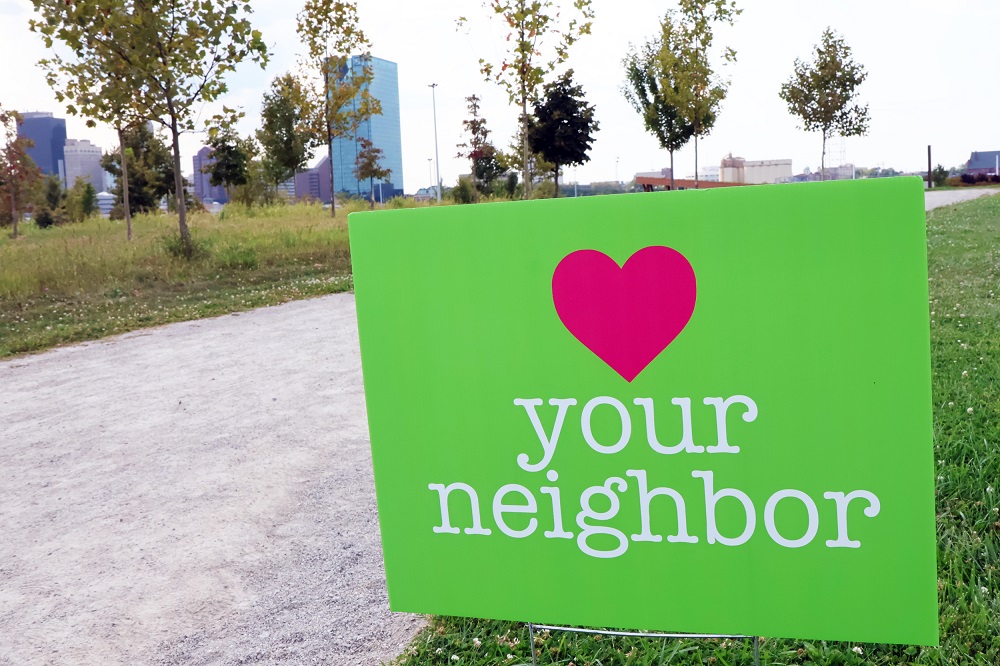

Nichols said Toledo embraced the initiative completely, and even Neighbor to Neighbor helpers and members of the organization’s congregation St. Michael’s are being intentional about promoting acts of kindness.
Nichols said she spearheaded the idea for the initiative in January because she was bothered by the major political divide in the community.
“This political divide has been hammered into our heads for the past 10 years,” she said.“We really wanted to push back against that because we really are just neighbors and we may vote differently, but we want to be able to live together in peace and to recognize and treat each other with kindness and respect.”
Nichols added that it is important to be kind all days of the year, but Neighbor to Neighbor is specifically asking people to be mindful of their treatment of others during this difficult political season because elections tend to cause a divide in communities.
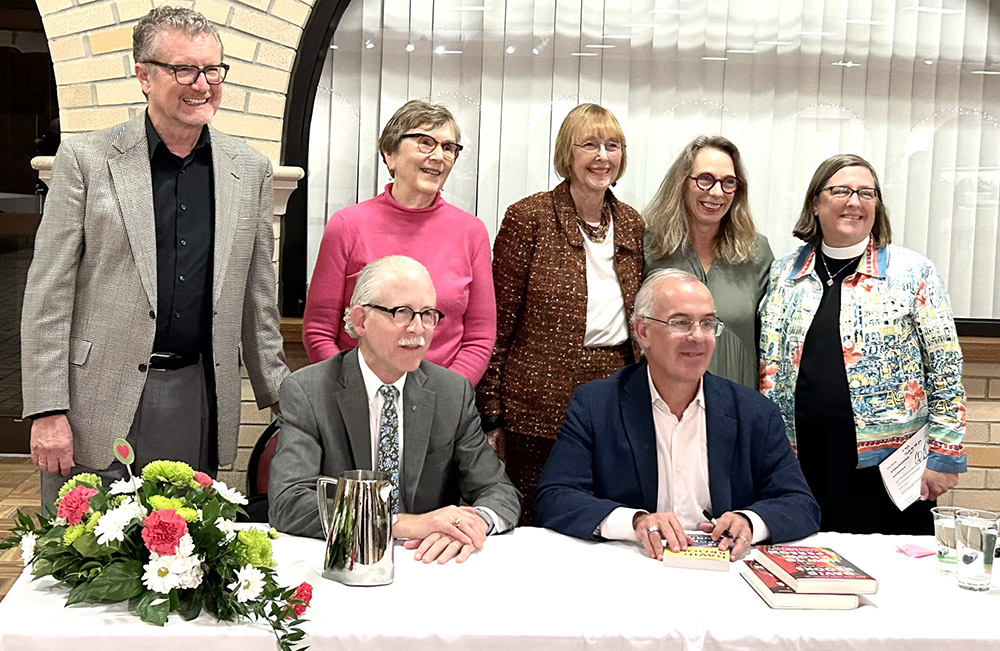

According to the Neighbor to Neighbor website, The City of Toledo, The Village of Ottawa Hills and The University of Toledo have declared Intentional Acts of Kindness Weeks, recognizing the need to increase the focus on kindness.
The initiative was supported by more than 40 donors, including Toledo Lucas County Public Library, Lourdes University, The Village of Ottawa Hills, The Multifaith Council of Northwest Ohio, and others.
Wade Fulkerson, a voter from east Toledo who visits the polls regularly, says through his political experiences that it’s important to be kind to others with different political views.
“To me, I believe that we should treat everyone as equals,” said Fulkerson.
Despite having opposing views than some of his family members on the major candidates, he says every vote matters and that he encourages registered voters to go out and cast their ballots on election day.
“It’s our choice to decide who we let in and who we don’t,” he said. “We have a choice and I encourage you to vote even if you don’t like either candidate.”
The “We Are Still neighbors” event, in collaboration with the MultiFaith Council of Northwest Ohio, is a simple supper of pasta, salad, bread and dessert, to be served to the public on a first come, first serve basis.
For a few ideas of kind gestures, visit the Neighbor to Neighbor’s website.
Issue 29 helps fund senior care
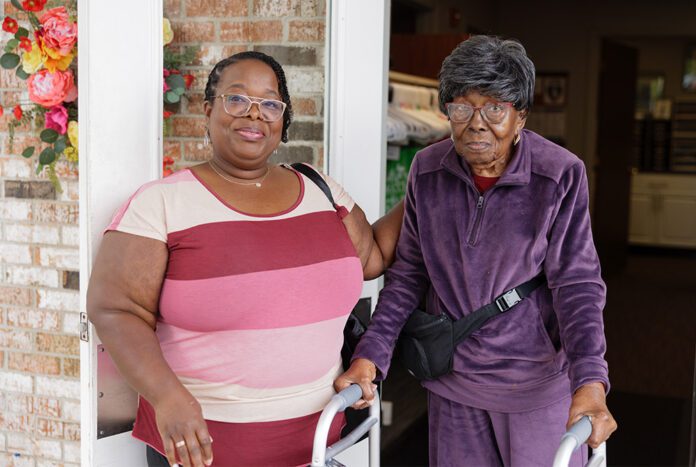

AOoA offers tips for aging parent caregivers
TOLEDO – Stephanie spends most afternoons at her dad’s house, cleaning up, organizing his medications and simply spending time with him. Michael picks up his mom’s prescriptions and groceries, while Sarah is taking care of her sister until she recovers from a recent surgery.
Stephanie, Michael and Sarah may be handling very different chores, but they have much in common: All are probably helping out while working full time jobs; they’re going through the emotional stress of caring for a loved one; and they’re often handling most financial responsibilities themselves.
They’re all caregivers, and they’re likely doing all of this without any outside help. There are an estimated 53 million adults (more than 1 in 5 Americans) who are unpaid caregivers to a loved one, according to a 2020 study from AARP and the National Alliance for Caregiving.
A potential solution would be to hire professional in-home caregivers or use outside facilities. But a long-term trend in the home health industry predicts a significant labor shortage among caregivers and nurses.
According to the U.S. Bureau of Labor Statistics, 1 million new home health and personal care aide jobs will be open by 2031. And despite recent increases in home healthcare workers’ pay, the labor shortages should continue.
Planning in advance
Justin Moor, president/CEO of the Area Office on Aging (AOoA) of Northwestern Ohio, recommends that caregivers contact AOoA when they’re first beginning to assist a loved one (over 60 years old).
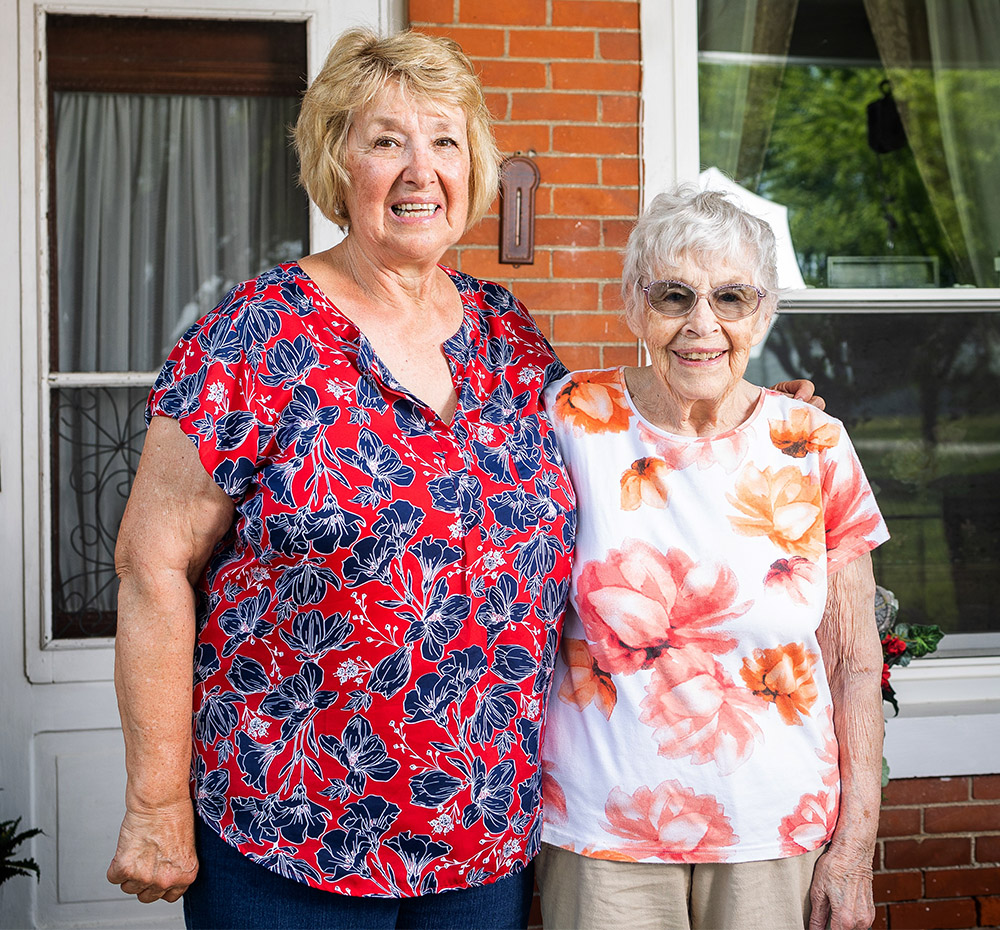

“Our social workers can visit families as a whole, or individually with the caregiver and the patient,” he said. “In that way, we can assess the current situation, and we’ll be ready to provide services whenever they’re needed.”
Short-term services include adult day care (through centers around the area), caregiver break times through the AmeriCorp Senior Program in your home, providing transportation of all types, among others.
Issue 29 on the Nov. 5 election ballot is a 1.0 mill renewal that would provide $8,148,000 annually to provide or maintain senior citizens services and programs. Many of AOoA’s programs are funded by this measure.
“A temporary break from caregiver services can be critical to well-being,” said Moor. “Caregivers most often forget to take care of themselves. This work is extremely important, but they don’t have to do it alone.”
He compares it to the instructions we all remember from taking a flight – put the mask on yourself before putting it on someone else. In addition to the short-term programs for adults, AOoA provides a range of counseling programs and support groups for caregivers, so they can focus on self-care.
Changing the narrative
According to Moor, caregiving was a very black and white conversation – either family provided it or paid services were called in.
“Here in Lucas County, the Area Office is entering that gray area,” by offering healthcare programs directly to caregivers, to help alleviate the estimated 22 hours per week caregivers provide, he said. AOoA is looking to reach caregivers in three “easy” steps:
#1 – We’re talking to you.
“Family members think caregiving has to be on their shoulders, but it doesn’t,” he said. “AOoA can supplement the care you’re providing. We want to be your care partner, because the result is better care for your loved ones.”
#2 – We feel your pain. Moor explained that any level of caregiving comes with stress:
- The emotional toll of the changes taking place in your family, concern about your loved one’s illness and uncertainty of the support you can provide
- The physical toll of the actual, long-term care of a loved one
- The financial toll of handling caregiving out-of-pocket
#3 – We can help. The AOoA provides a full range of programs for caregivers, from offering a temporary break or daycare in the short term, to longterm assistance and support programs.
But Moor says that while “better decisions are made when there’s no emergency, most caregivers come to us later than they should” to arrange for services.
Changing caregiving in the future
AOoA is working through the federal Older Americans Act to offer services, like drop-in day care, exercise, massage, counseling and support groups through some of the region’s 45 senior centers. These programs should be available within the next two years.
In Ohio, Medicaid and the Veterans’ Administration offer programs to pay family members to provide specific care programs to their loved ones. In addition, the AOoA and Lucas County Commission in Toledo, and Principle Business Enterprises in Bowling Green are joining together to survey their employees about caregiver challenges and awareness of available services. That survey and its recommendations should be complete in early 2025.
In the meantime, learn more about caregiver services from AOoA by calling 419.382.0624.








